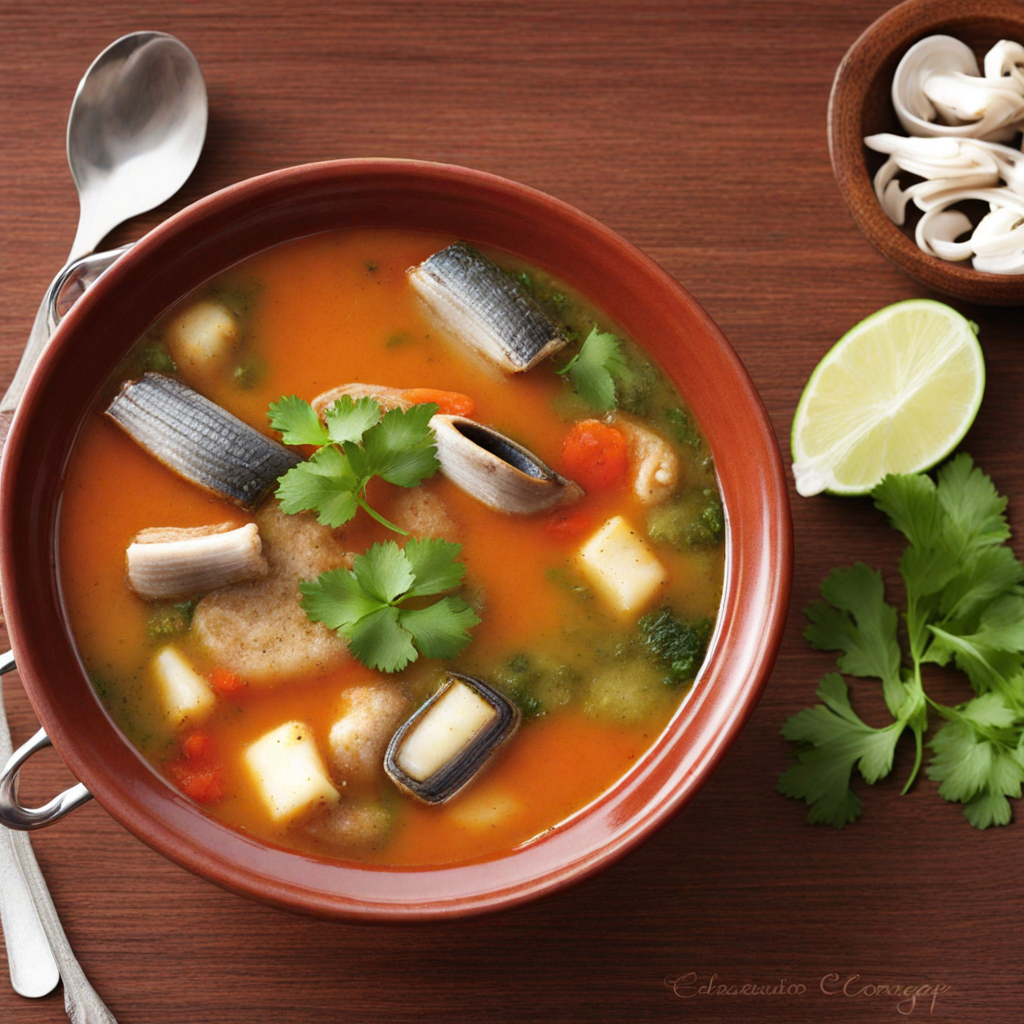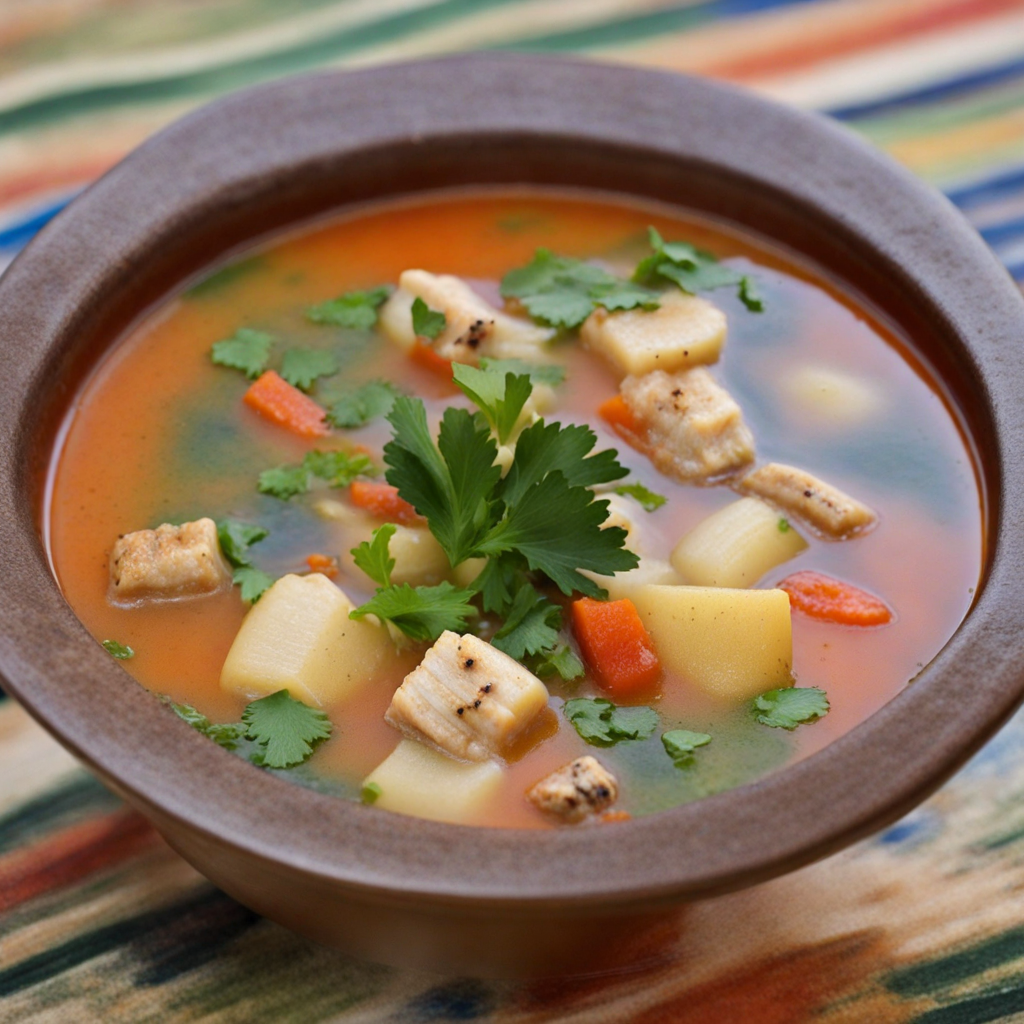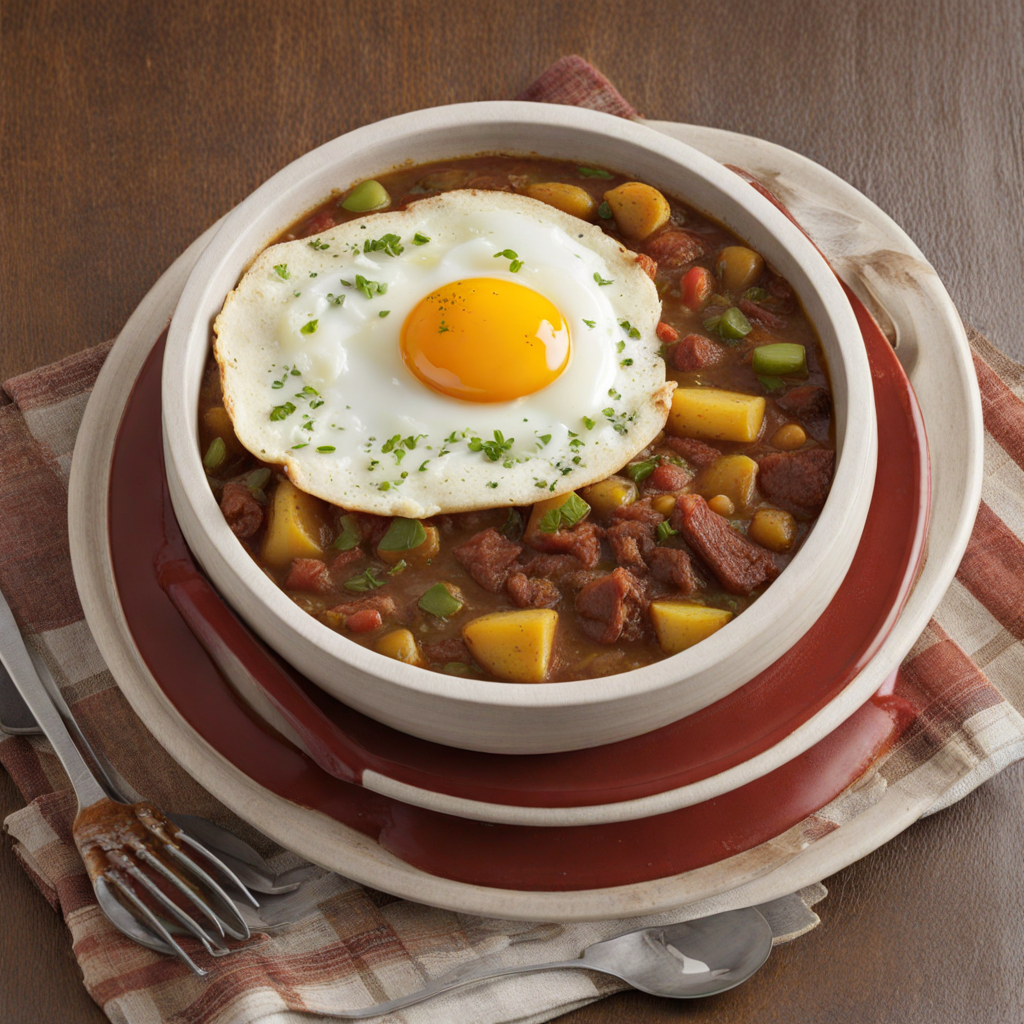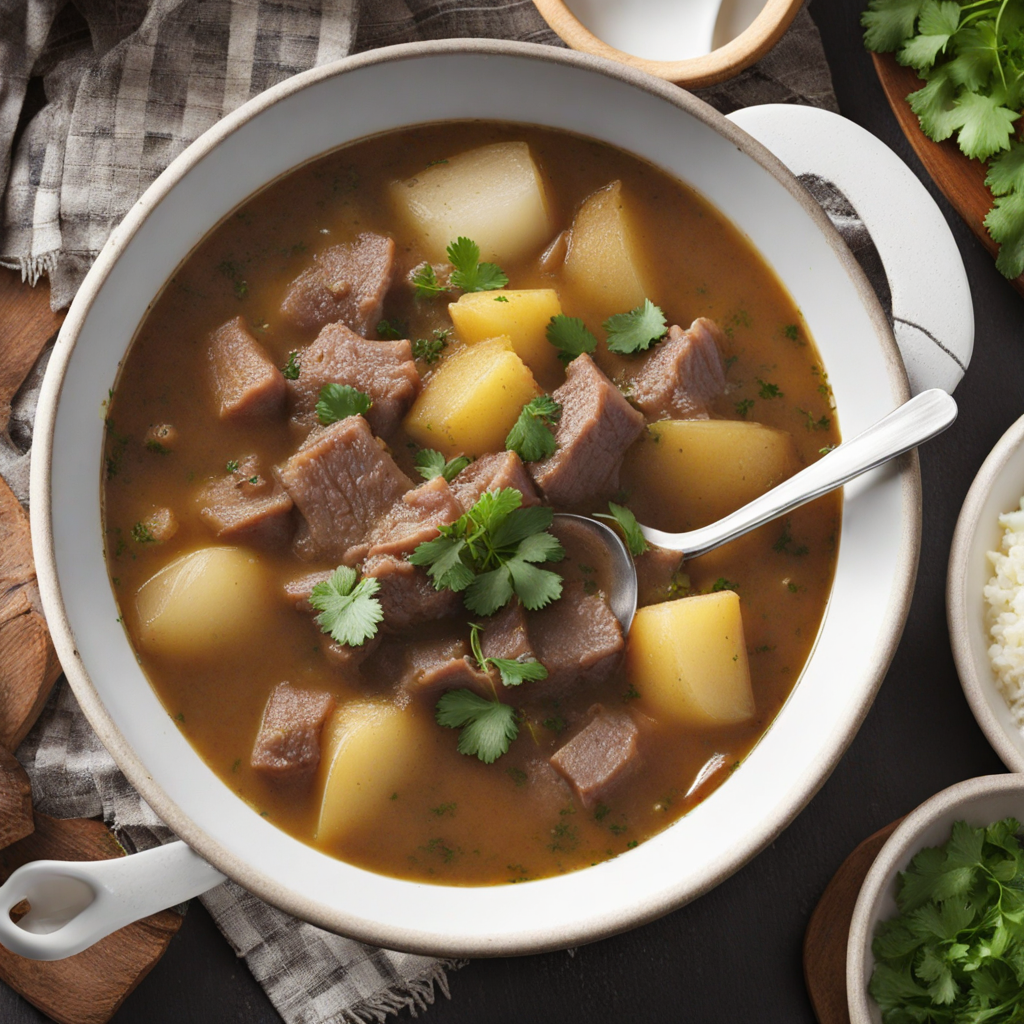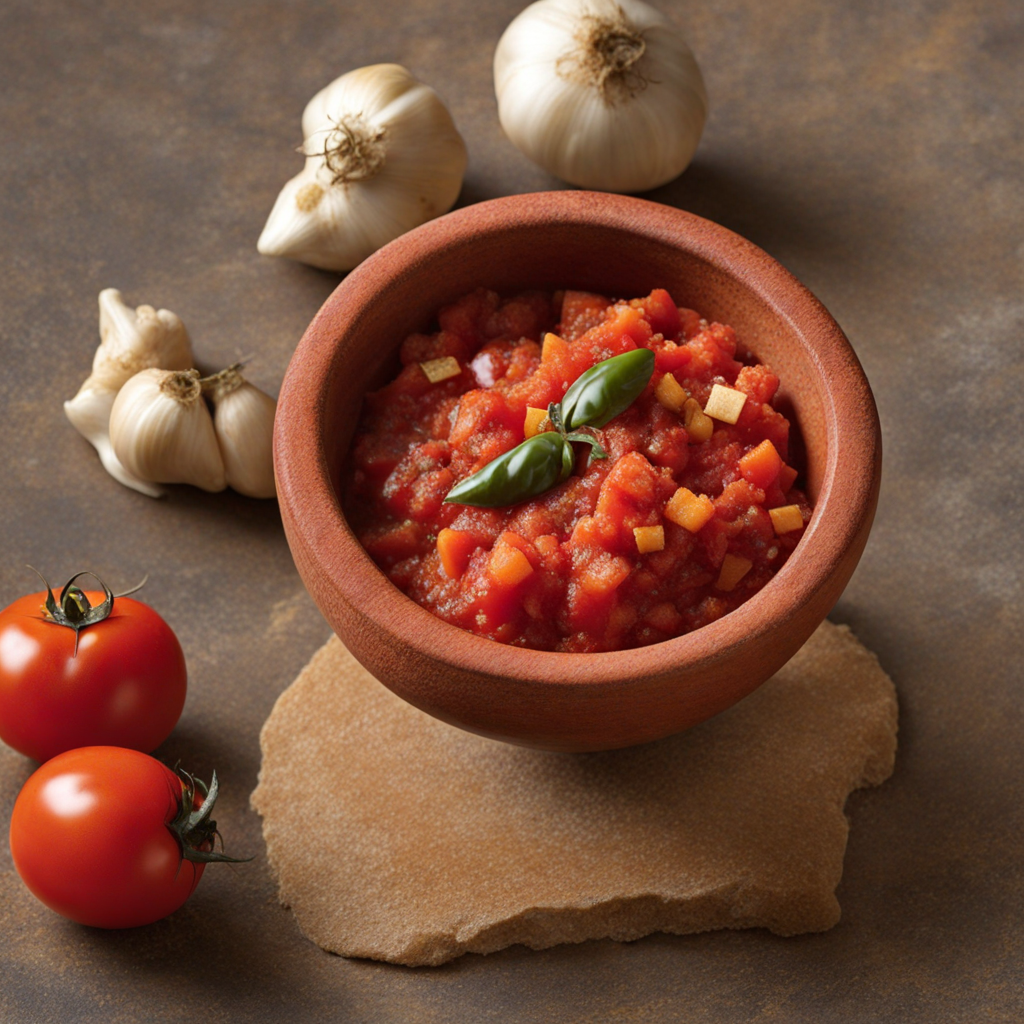Caldillo de Congrio
Caldillo de Congrio is a traditional Chilean dish that beautifully showcases the rich flavors of the Pacific Ocean. At its core, this hearty fish stew features the conger eel, a delicacy prized for its tender, flaky meat and subtle flavor. The dish combines the eel with a medley of fresh vegetables, including potatoes, onions, and tomatoes, all simmered together to create a satisfying and aromatic broth. The use of local herbs and spices, such as cilantro and paprika, adds depth and warmth, making each spoonful a comforting experience. What sets Caldillo de Congrio apart is the way it celebrates the natural flavors of its ingredients. The conger eel is typically cooked slowly, allowing it to absorb the savory essence of the broth while ensuring a melt-in-your-mouth texture. The freshness of the vegetables adds a vibrant contrast, with the potatoes providing heartiness and the tomatoes lending a touch of acidity that balances the richness of the eel. This dish is often enhanced with a squeeze of fresh lemon or lime juice, elevating the flavors and adding a zesty brightness that invigorates the palate. Caldillo de Congrio is more than just a meal; it’s a cultural experience that reflects the coastal heritage of Chile. Often enjoyed alongside a crusty piece of bread or rice, it invites diners to savor the simplicity and elegance of Chilean cuisine. Whether enjoyed on a chilly evening or as a comforting family meal, this dish embodies the spirit of home-cooked comfort, making it a must-try for anyone looking to explore the diverse and delicious offerings of Chilean gastronomy.
How It Became This Dish
The History of Caldillo de Congrio: Chile's Culinary Treasure Caldillo de Congrio is a traditional Chilean dish that embodies the rich maritime culture of the country. A hearty fish stew, it showcases the culinary heritage of Chile, particularly in its coastal regions. The dish is primarily made with congrio, a type of eel-like fish found in the waters around the Chilean coast, along with a medley of vegetables and spices that elevate its flavor and warmth. To understand the depth of Caldillo de Congrio, we must delve into its origins, cultural significance, and evolution through the ages. #### Origins The origins of Caldillo de Congrio can be traced back to the indigenous peoples of Chile, particularly the Mapuche and other coastal communities, who relied heavily on the ocean for sustenance. The coastal geography of Chile, with its long coastline and rich marine biodiversity, provided a plethora of seafood options. The congrio fish, known for its firm flesh and unique taste, became a staple in the local diet. The preparation of fish stews is not unique to Chile; many cultures around the world have their own variations. However, the distinctiveness of Caldillo de Congrio lies in its ingredients and preparation methods, which have been influenced by both indigenous practices and Spanish colonial traditions. The Spanish arrived in Chile in the 16th century, bringing with them their culinary techniques and ingredients, such as onions, garlic, and various spices. These ingredients melded with local practices to create a dish that reflects a fusion of cultures. #### Cultural Significance Caldillo de Congrio holds a special place in Chilean culture and identity. It is often regarded as a comfort food, evoking feelings of home and familial warmth. Traditionally served during family gatherings and special occasions, the dish symbolizes togetherness and community. It is not uncommon for Chileans to share stories and create memories over a pot of Caldillo de Congrio, making it more than just a meal—it is a cultural ritual. The dish is also significant in Chilean folklore and literature. One of the most famous mentions of Caldillo de Congrio comes from the renowned Chilean poet Pablo Neruda, who celebrated the dish in his works. Neruda's vivid descriptions of Chile's landscapes and culinary delights have contributed to the national pride surrounding traditional dishes like Caldillo de Congrio. In many ways, the dish embodies the spirit of Chile—its oceanic bounty, cultural richness, and the warmth of its people. #### Development Over Time As Chilean society evolved, so did Caldillo de Congrio. In the early 20th century, the dish gained popularity beyond local households and became a staple in restaurants, especially in coastal towns such as Valparaíso and Concepción. Chefs began to experiment with the recipe, incorporating regional ingredients and modern cooking techniques while still honoring the traditional preparation methods. In the 1960s and 1970s, during a time of social and political change in Chile, Caldillo de Congrio became associated with national identity. The government promoted the dish as a part of Chilean cuisine, emphasizing its local origins and the importance of supporting domestic fisheries. This movement led to an increased appreciation for traditional foods, and Caldillo de Congrio emerged as a symbol of national pride. As Chilean cuisine continued to evolve in the late 20th and early 21st centuries, chefs began to reinterpret Caldillo de Congrio, blending it with global culinary trends. Fusion cuisine brought new flavors and techniques into the dish, allowing it to appeal to a broader audience both within Chile and internationally. While these modern interpretations may vary from the traditional recipe, they demonstrate the adaptability and resilience of Chilean culinary traditions. #### Traditional Recipe and Ingredients The traditional recipe for Caldillo de Congrio is relatively simple, emphasizing fresh ingredients. The core components include: - Congrio: The star of the dish, congrio is often used for its meaty texture and rich flavor. It is typically cut into large chunks to withstand the cooking process. - Vegetables: Commonly used vegetables include onions, tomatoes, and potatoes, which add depth and heartiness to the stew. - Herbs and Spices: Fresh cilantro, garlic, and bay leaves are typical, offering aromatic and herbal notes that enhance the overall flavor profile. - Liquid Base: The stew is often made with fish stock, water, or a combination of both, seasoned with salt and pepper to taste. The preparation involves sautéing the vegetables, adding the congrio, and then simmering everything together until the fish is cooked through and the flavors meld beautifully. The result is a fragrant, comforting dish that warms the soul. #### Modern-Day Caldillo de Congrio Today, Caldillo de Congrio continues to be celebrated in Chilean homes and restaurants. It is often served with crusty bread or rice, allowing diners to savor every drop of the flavorful broth. In coastal towns, fishermen often serve their freshly caught congrio in traditional stews, maintaining the link between local fishing practices and culinary traditions. In recent years, the dish has gained international recognition, leading to its inclusion in various gastronomic festivals and events celebrating Chilean cuisine. Chefs both in Chile and abroad have embraced Caldillo de Congrio, showcasing it in fine dining restaurants and culinary competitions, further solidifying its status as a Chilean culinary icon. #### Conclusion Caldillo de Congrio is more than just a dish; it is a testament to Chile’s rich cultural history, reflecting the influence of indigenous peoples and colonial heritage. Its evolution over time tells a story of resilience, adaptability, and a deep connection to the sea. As Chile continues to embrace its culinary roots while exploring modern interpretations, Caldillo de Congrio stands as a cherished symbol of national identity and pride, bringing people together around the table, one warm bowl at a time.
You may like
Discover local flavors from Chile


